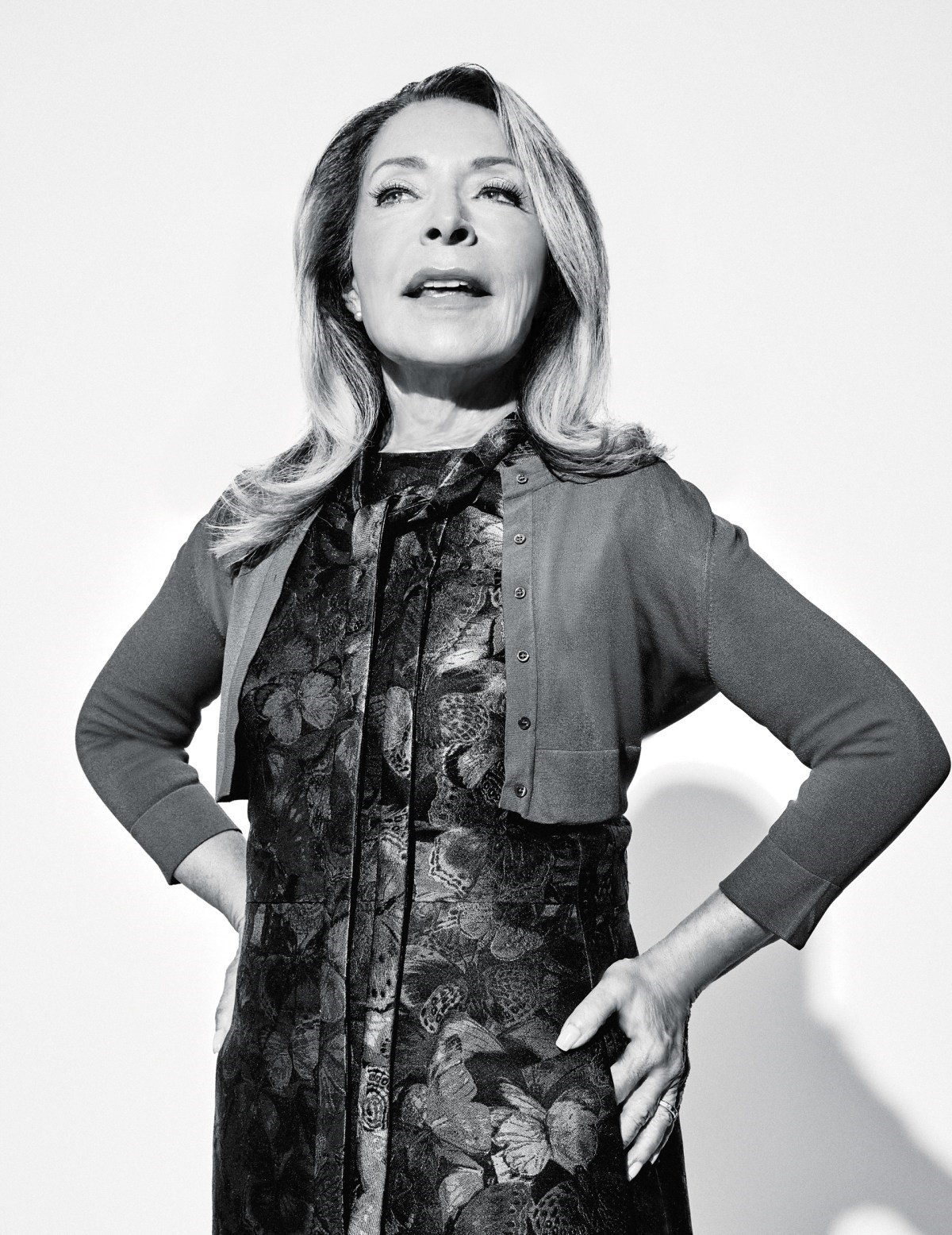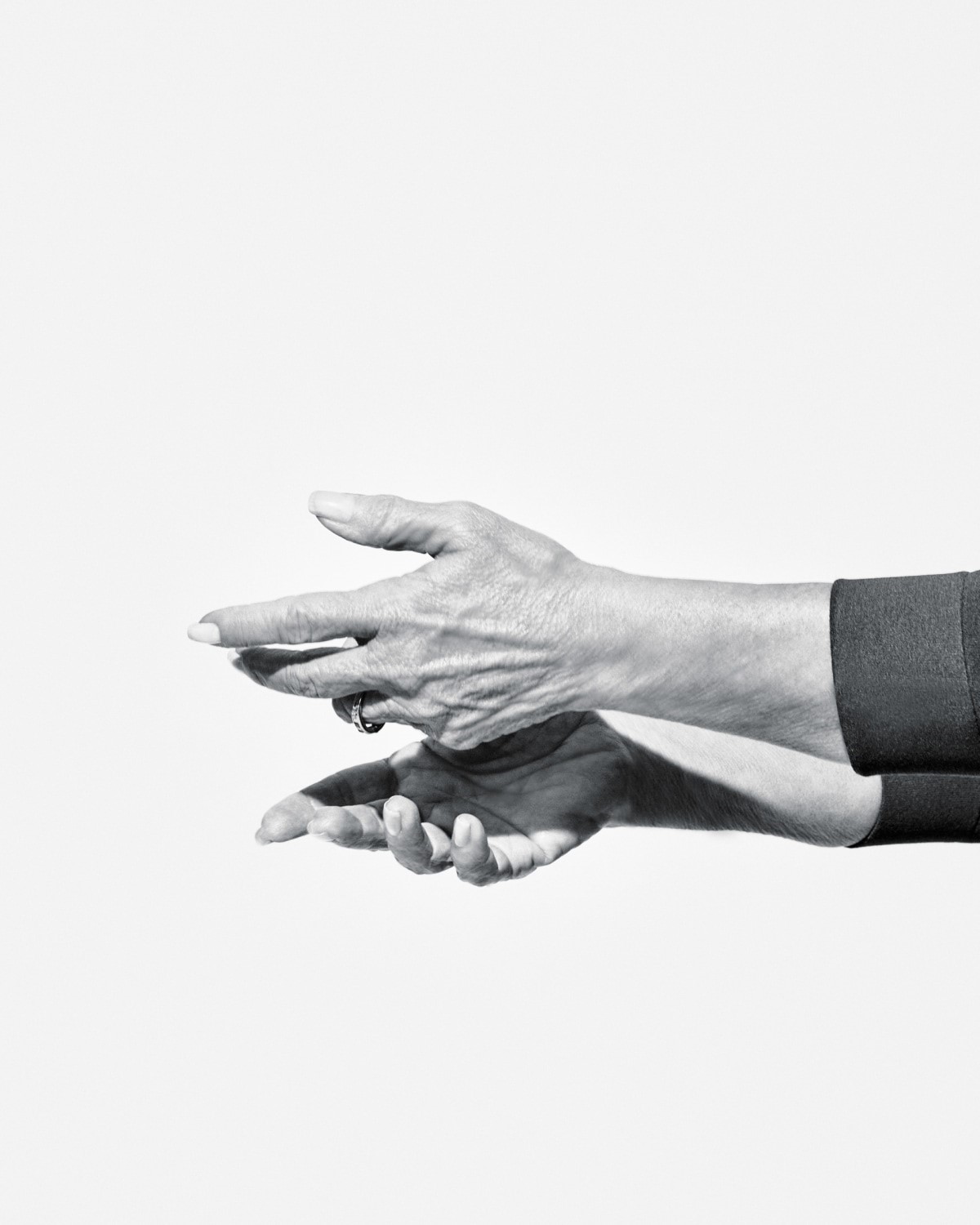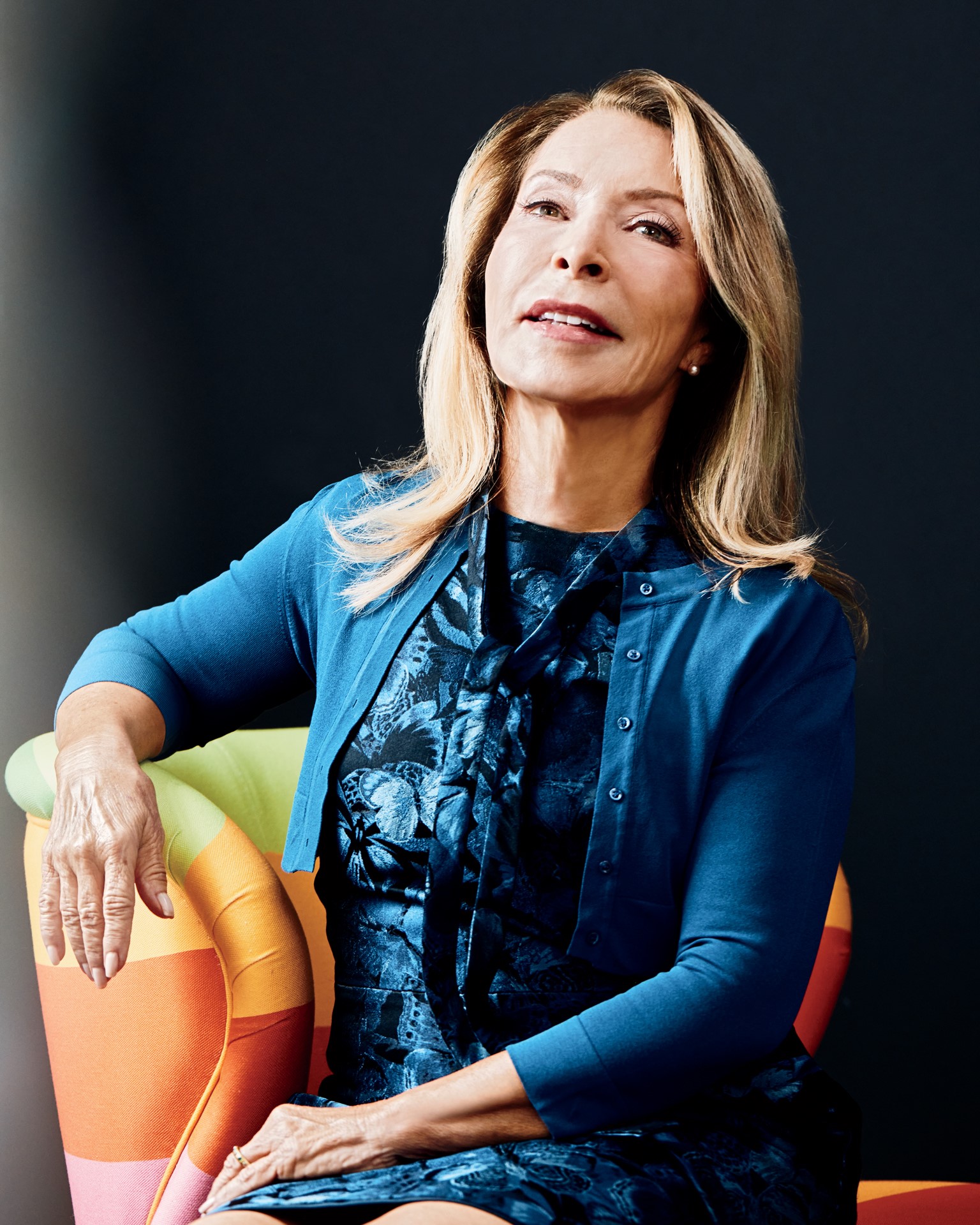Paula Wallace has invited me to tea. The founder and president of the Savannah College of Art and Design (SCAD) recently returned to the school’s coastal Georgia home after an extended visit to its campus in the South of France, and so on a humid July day, down a street lined with towering live oaks, I arrive at a redbrick, fortresslike structure with green turrets and ornate wrought ironwork, where we’ve agreed to meet.
The building was constructed in 1892 as an armory for Savannah’s volunteer army, but in 1979, the then-30-year-old Wallace decided to buy it. For years, she’d been dreaming of opening an arts college that would prepare students to earn a living doing what they loved. She stumbled upon this handsome, somewhat derelict, building and thought it looked promising. To pay for it, Wallace sold her beloved yellow Volkswagen Beetle, and her parents donated part of their retirement savings to the cause. She moved in, and with her family’s help, scrubbed the floors and repainted the walls. Six months later, SCAD opened its doors to its first class of 71 freshmen.
This is SCAD’s origin story, and it has now been packaged up into a tourist attraction—called, yes, SCADstory—which occupies the ground floor of what is now Poetter Hall (Wallace’s parents’ surname). When you step into a room, the lights dim, then the clock and paintings on the wall come to life, much like in the Haunted Mansion ride at assorted Disneyland theme parks around the world, which makes sense because SCAD’s “themed entertainment” students helped craft it. The experience is even narrated by a perky cartoon version of Wallace, frozen forever in her youth.
Wallace, now 74, has always been animated by her mission to create a world where there are no starving artists. “Back then, artists who cared about making a living were called sellouts,” she says. “There was the idea that artists had to suffer. I never wanted that for our students. I wanted them to have happy, rewarding lives after SCAD. I decided we had to be business-oriented.”
Early on, this meant finding students jobs as interior designers, printmakers, and textile designers. In the decades that followed, as design became a transformative force in corporate America—helping to turn Apple and Google into the world’s most valuable companies—Wallace kept pace, expanding SCAD’s offerings to include degrees in graphic design, game development, visual effects, and theme-park design. SCAD brings in top companies, such as BMW, Hermès, and Disney, to work with students on real business problems, allowing them to bolster their résumés and networks.
None of SCAD’s 16,000 students are likely to starve: The school says that 99% of them are employed within 10 months of graduation or furthering their education, and the university’s 50,000 alumni occupy creative roles everywhere from Coca-Cola to NASA.
At teatime, Wallace ushers me into a parlor on the second floor of the armory, just above SCADstory. There, a three-tiered cake stand, neatly stacked with ginger snaps and cucumber sandwiches, and a silver teapot with two vintage teacups in a charming blue toile pattern, are artfully laid out on top of coffee-table books. The room we’re in features deep purple walls that contrast the original white crown moldings and three still-life paintings of popcorn kernels by Jenny Eitel, who received her BFA from SCAD in 2012. They’re among 20,000 pieces of student and alumni art that the university has purchased at market rates to beautify its spaces, and inspire students.
Wallace completes the tableau on a periwinkle-blue leather sofa, her blue floral, knee-length dress lengthening her petite frame. She’s carrying a miniature white tote bag made by Telfar, a hip designer she loves. Given Wallace’s reputation as a visionary, I expect her to have an imposing, larger-than-life presence; instead, she’s demure and soft-spoken, with the slightest hint of a Georgia twang. “The tea is from Mariage Frères,” she explains, as an assistant fills our vintage teacups. “I brought it back from Paris for the grand opening of the college’s tea room, but it got held up at Newark Airport because they thought it was contraband.”

Her responsibilities are wide-ranging. She oversees campuses in Savannah, Atlanta, and Lacoste, France. She hosts SCAD’s annual film festival (last year’s event featured appearances by Janelle Monáe, Ron Howard, and Eddie Redmayne). She’s expanding Savannah Film Studios, which will encompass an 11-acre Hollywood-style back lot. Wallace remains intimately involved in students’ day-to-day lives, sitting in on seniors’ final project presentations and signing off on the interior design of campus spaces. Did she personally pick out the vintage statue of Mayor McCheese that stands on the balcony in front of us? She did. “It makes me happy,” she says, with a laugh. “A bit of whimsy.”
These efforts have built an institution that supports 2,000 employees (including 800 faculty) across its three locations and has net assets of more than $1.3 billion. In its 2022 fiscal year, which ended in June 2022, it reported $622.4 million in revenue and a surplus of $106.8 million. That makes SCAD two to five times larger than such rivals as Pratt Institute, Rhode Island School of Design (RISD), and California College of the Arts. Wallace is well-compensated for the work: She’s among the highest-paid college presidents, earning more than $2.5 million in fiscal 2022, more than double the salary of Harvard’s president.
“Wallace has created a disruptive and scalable business model,” says John Maeda, who served as president of RISD from 2008 until 2014 and is currently Microsoft’s VP of design and AI. “At RISD [founded in 1877], there were certain things I knew the school was good at and I should never change. I admired what a newer brand could get away with.”
SCAD’s rise is the story of a scrappy family business that grew to become a billion-dollar brand, led by a relentless entrepreneur who built a forward-thinking art school able to respond to corporate America’s embrace of creative-class employees. But SCAD and its graduates face challenges like never before. Although the school continues to grow—at a rate four times faster than the average college—it now has fierce competition. Both the University of Texas at Austin and Stanford have been investing heavily in their career-oriented design schools; Stanford’s d.school finally offers its own degree programs.
Meanwhile, companies are increasingly gigifying creative work and exploring how AI can enable them to do more with fewer people. Some design experts argue that it is better for schools to train generalists, capable of nimbly adapting to the evolving demands of the workplace, rather than hyper-specialized designers. “As an educator, you want to develop the designer’s abilities but not necessarily to the point that they can walk into a job and start working on day one,” says Anthony Pannozzo, head of leading design firm Frog. “You can put those entry-level workers on a project right away, but then you look at the work, and it is not creative or inspired. You don’t get a fresh view of how design is manifesting in the world and how people are reacting to it.”
SCAD became an influential force in the design world by perpetually morphing to meet the needs of the marketplace. But amid intense competition and a velocity of technological and business change beyond anything the school has ever experienced before, can SCAD keep adapting quickly enough to keep its edge?
On seemingly every corner of Downtown Savannah, there’s a building emblazoned in large gold lettering with “The Savannah College of Art and Design.” The school name is spread across more than 60 of them, many as old and grand as Poetter Hall. The art museum, for example, is housed in the oldest surviving antebellum railroad complex in the United States, built in 1853. The student center inhabits a former synagogue, built in 1909, which boasts colorful stained glass windows and two white domes adorned with the Star of David. A tourist might assume the university is as old as the city itself, much like Harvard is entwined with Cambridge, Massachusetts, or how Columbia shaped New York City’s Upper West Side.
Wallace never expected SCAD to grow to this scale, generating $766 million in economic impact annually for the state of Georgia as of 2020, and transforming her adopted city into a design-forward tourist destination. Her initial ambitions were more modest. Wallace, who had begun her career as a public elementary school teacher in Atlanta, wanted to adapt her unconventional pedagogical techniques—transforming her classroom into a Calderesque circus or building a stage for oratory performances—for college students.
Wallace’s immediate family moved to Savannah with her. May, her mother, ran admissions, while her father led operations. Her then-husband, Richard Rowan, served as the school’s president for 22 years before departing to become a racehorse breeder after the couple’s divorce. In 2017, The Atlanta Journal Constitution reported that 13 members of Wallace’s family, including her second husband, have worked for SCAD, earning more than $60 million over 20 years. “For Wallace,” the paper declared, “the personal and the professional are barely distinguishable.”
Wallace herself was always most interested in the curriculum, so she took the role of academic dean. She developed SCAD’s rigorous, Bauhaus-inspired core curriculum in art theory, history, and practice, which every student must take in their first year. It includes coursework in drawing, color theory, and design, along with liberal arts classes devised to help students think critically about their subsequent major. Design 115, for instance, teaches the principles of adaptive thinking and creative problem-solving so future industrial designers or fashion-management students will seek out opportunities to innovate.
“The philosophy was to immerse every student in art, whatever they would eventually major in, to situate their work within a broader context,” says Chuck Chewning, an interior designer who graduated from SCAD in 1986. He had started pursuing a degree in architecture at Georgia Tech, but was ready to quit after freshman year because he found the engineering school’s approach too technocratic. He’d heard about SCAD and was willing to take the risk of enrolling in a college founded only four years prior because he loved the sound of these foundational courses. “I didn’t even wait to transfer in the fall,” he says, “I transferred right then in the summer.”
While Wallace wanted students to be engrossed in these theoretical concepts, she has never wavered from her mission to ensure that students would be gainfully employed when they graduated. This meant keeping a close eye on where the creative jobs were and making sure students were prepared for them. Almost 40 years ago, as personal computers gained popularity, SCAD received the first-ever order of the Commodore Amiga. Its graphics and audio systems were significantly better than those of previous models, so students could learn graphic design.

Decades later, Wallace’s curriculum remains the bedrock of SCAD’s first year of study, but students then select from one of the school’s 100-plus degree programs and specialize in an often hyper-targeted discipline, ranging from accessory design to immersive reality. “One thing that SCAD is known for is being nimble,” Wallace says. “As it seemed to serve the best interest of our students, we have added majors, degree programs, and schools. I can see the disciplines taught here may be very different in the future.”
That initial grounding, though, is what graduates rely on as they pursue their careers. Madison Hamburg, a 2014 graduate who directed, produced, and starred in the 2020 HBO series Murder on Middle Beach, says that his core classes continue to shape his approach to documentary filmmaking. “Understanding composition and color theory is extremely important when developing the language of film,” he says. “I have many colleagues who didn’t go to art school, but I can’t imagine trying to tell a story in a film without that basic knowledge.”
When companies as varied as McDonald’s and Warby Parker saw the value that Apple and Google garnered as design-centric companies, Wallace was ready to meet the moment. She trained an army of creatives in industrial design, UX, animation, game development, and social strategy. And more than that, she wooed companies to campus so they would work directly with—and hire—her students.
As evening falls and a cool breeze wafts over Savannah, I walk over to Husk, a chic farm-to-table restaurant housed in a former mansion that offers a modern take on Southern cuisine. My dining companion is John Paul Rowan, SCAD’s CMO and the co-lead of SCADpro, a program that allows companies to hire SCAD students for a 10-week stint to solve real business problems.
As we settle in, Rowan studies the wine list with the care you might expect of someone who attended the Cordon Bleu in Paris and briefly toyed with becoming a chef. He picks a crisp chardonnay that will go nicely with my shrimp and grits and sorghum biscuits. When the waiter pours him a taste, he says the wine is perfect, but politely asks for another glass, since his is cloudy from the minerals in Georgia’s water.
Rowan’s keen attention to detail is reminiscent of Wallace . . . who just happens to be his mother. Rowan was born four years after SCAD’s founding and grew up alongside the college that his parents and grandparents were building. As a child, he saw the faculty as surrogate uncles and aunties. Once, he built a 3D structure for a high school project, and his mother asked a SCAD architecture professor to swing by the house to offer some feedback. “The professor said, ‘You can fucking do better,’” Rowan recalls. “I didn’t feel upset—I realized I was capable of more. I’ve taken that lesson with me.”
He pursued a career as a real estate developer and brand marketer, but he found his way back to SCAD in 2009. “We should empower our students to do big things,” he says, “minus the expletives.”
This is the approach Rowan brings to SCADpro, which he describes as a design agency, akin to Ideo or Frog, that companies can hire to work on relevant initiatives. Since it launched in 2010, hundreds of top brands have signed up, some for multiple assignments. Ford asked SCADpro students to reimagine the future of car buying. They collaborated with Gulfstream Aerospace on flight-deck console designs. NASA asked students to develop educational materials and participate in website redesigns. Often, SCADpro products end up going to market. Students designed a collection of shoes for Sam Edelman that will appear at Nordstrom this fall. “We hold our students to true professional standards,” Rowan says.
SCAD markets the program to brands as an extended focus group with Gen Z consumers and a source of fresh ideas grounded in the latest academic research. Clients pay a fee that varies depending on the scope of the project, but Rowan says it is not a major source of revenue for the university. The companies get to keep all intellectual property that ensues, but they must allow the students to include the project on their résumé and show examples of the work in their portfolio, even if the project would otherwise be governed by a nondisclosure agreement.
“Partnering with SCADpro allows us to get out of our bubble a little bit,” says Utkarsh Seth, a senior staff UX manager at Google who has participated in several SCADpro projects. “We get to explore these ideas with bright students and faculty, which leads to phenomenal outcomes. Sometimes, it validates the direction our company is going, and sometimes it provides new insights about what product development we need to do.”
While students don’t get paid for SCADpro work, the experience can be a career-launching opportunity, and classmates compete for limited slots. So far, more than 7,000 have participated in SCADpro, roughly 250 of whom have received job offers directly from projects, while hundreds of others have leveraged the experience to land jobs elsewhere. In the NASA project, animation student Adriana Manrique was hired on the spot as a multimedia specialist to work on the 2021 launch of the James Webb Telescope. Tabish Ahmed, an interactive design and game development student, did a SCADpro project with Adobe, which led him to snag a job at Google even before he graduated as valedictorian in 2014. “There’s a culture of being self-motivated at SCAD that stuck with me,” says Ahmed, who spent almost six years working on YouTube and Pixel devices before moving to Meta and then launching his own game development startup in 2023. “You’re encouraged to put yourself out there.”
SCAD’s intimate partnership with companies has prompted the university to launch entirely new degree programs. For instance, Google came to SCAD with the observation that there was a gap in the education system when it came to training people to conduct user testing and understand human behavior. In 2016, Google and SCAD cocreated a BFA in user experience, the first four-year undergraduate degree of its kind. Last year, the two organizations collaborated again to introduce a BFA in user-experience research. While Google helped craft these programs to meet needs within its own organization, students will go on to work in many companies. UX alumni have landed jobs at eBay, Mailchimp, and Bank of America. “The art and craft of user experience changes so dramatically when you step out of an academic institution and into industry,” says Google’s UX manager Seth, who contributed to the development of these user-experience degrees. “We’re trying to bridge that gap between academia and industry to shorten the ramp-up time as much as possible.”
This kind of corporate coziness can sometimes make SCAD feel more like a trade school than an elite international university, and it inspires questions about the role of a creative education itself. Tailoring the curriculum to the needs of the current job market undoubtedly makes SCAD students attractive to employers. But as the skills needed to succeed not just in a specific role in a specific company but over the course of a career are changing at an unprecedented speed, some experts argue that SCAD’s corporate orientation may be shortsighted.
“There are dimensions of design where the hard-core specialization really matters, like the shoe industry or the automotive industry,” says Frog’s Pannozzo. “But the fundamentals of being a good designer are about understanding and framing problems, then offering creative solutions. The way to achieve this is to take a conceptual path, developing students’ minds and creative sensibilities.”
The day I arrive at SCAD, there’s buzz that Leslie Odom Jr. is visiting the campus. The Tony Award–winning actor has partnered with Hyundai to film a series of short, documentary-style videos in SCAD’s studios. This kind of celebrity sighting is common. On any given day, Mindy Kaling might be giving a talk about her new show, or Maggie Gyllenhaal is on campus to teach an acting class. During the college’s film festival in October, Savannah is lousy with A-listers.
In 2006, Georgia started offering the entertainment industry tax incentives, and Disney and others set up shop here. While many productions chose Atlanta, Wallace saw an opportunity to entice filmmakers and stars farther south. In 2014, SCAD opened the Savannah Film Studios, equipped with green screens and postproduction rooms, and Wallace is now spearheading a massive, multimillion-dollar expansion—phase one will be completed later this year—that will be the most comprehensive film-studio complex in higher education.
“When the industry flocked to Georgia, we saw our students getting squeezed for resources to do their own shoots,” says Andra Reeve-Rabb, dean of the SCAD School of Film and Acting. “The idea of a back lot was crazy, but it solved a lot of problems. And if you can convince President Wallace that something will have a proven benefit for students, she will make it happen fast.”
Just as important, SCAD wants brands and production companies to use its studios and give students the chance to work on professional jobs, in everything from sound design to visual effects to acting. SCAD is the only university to have its own in-house casting studio, run by Reeve-Rabb, who began working at SCAD in 2009 and was formerly director of CBS’s prime-time casting. At CBS, she remembers reaching out to performing arts schools to cast students for The Big Bang Theory and being told that they didn’t want them working professionally until they’d graduated. “It was such a missed opportunity,” she says. SCAD students have been cast in more than 1,000 roles, in such productions as The Underground Railroad and The Politician.
To visit the Savannah Film Studios, I hop in a car and head 10 minutes west, watching the charming tree-lined streets of Downtown Savannah give way to dirt roads and dusty farmland. Past a defunct gas station that has been turned into a makeshift fruit stand, a massive construction site rises on the horizon as the contours of the back lot take shape. There will be a town square, encircled by trees and surrounded by facades of buildings in different architectural styles, from New York brownstones to Mediterranean houses with striped awnings.
Inside is an LED soundstage known in the industry as the Volume. It’s the next generation of filmmaking technology that blends the digital and physical worlds, creating an immersive, digital 3D set that allows actors to get more easily into character. David Yurman, the luxury jeweler, has hired SCADpro to bring students from across disciplines to work on the brand’s holiday campaign, which includes filming on the Volume here.
At the studio, students operate the computers and adjust the images on the LED screens, as actors traverse the stage. This technology has only been used in a handful of productions, most notably The Mandalorian, but these studios will soon be widely used in Hollywood. “[This technology] will create lots of jobs very soon,” says filmmaker Madison Hamburg, “and there are currently not many people who have this expertise.” SCAD students, however, will.
But filmmaking—like many other industries—is in the throes of a technological revolution. AI will soon be able to do the work of special effects artists, screenwriters, actors, and more. SCADpro’s Rowan tells me that he’s spending a lot of time talking to companies about how generative AI will impact the hiring landscape. “It’s important to listen to industry,” he says, “and not just be stuck in our academic world.”
Wallace is similarly undaunted. “Here, we’re always projecting into the future.” Later that day, I see her stopped at a red light, on her way to dinner with Odom. The light turns green, and she’s off.
(2)









